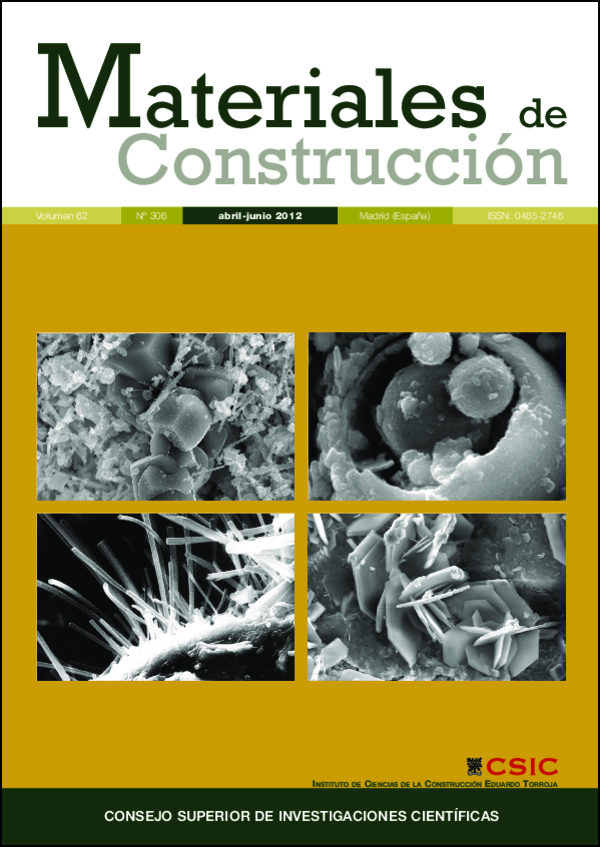Durability of fired clay bricks containing granite powder
DOI:
https://doi.org/10.3989/mc.2012.60710Keywords:
weather resistance, waste, durability, clay brickAbstract
Over the past few decades, hundreds of papers have been published on the benefits of including rock powder as a raw material in fired clay brick manufacture. Very little has been written, however, about the durability and long-term behaviour of the final product. As a rule, the ceramic bricks used in construction in developing countries are fired at low temperatures, which detracts from their mechanical performance. This is particularly visible in harsh environmental conditions, where weathering causes severe deterioration. The present paper describes the impact of weathering on clay bricks containing from 0 to 10% granite powder, an industrial by-product. The specimens were fired at 500, 700 or 900 ºC and subsequently exposed to natural environmental conditions or accelerated laboratory weathering. Their physical and mechanical properties were evaluated to determine the effect of the composition of raw materials on fired clay product durability.
Downloads
References
(1) Xavier, G. C.: “Resistência, Alterabilidade e Durabilidade de Peças Cerâmicas Vermelhas Incorporadas com Reíduo de Granito”, Ph.D. Thesis (2006), Department of Civil Engineering, State University of Norte Fluminense Darcy Ribeiro, Campos dos Goytacazes, Rio de Janeiro, Brazil (in Portuguese).
(2) Maia, P. C. A.: “Avaliação do Comportamento Geomecânico e de Alterabilidade de Enrocamentos”, Ph.D. Thesis (2001), Department of Civil Engineering, Catholic University of Rio de Janeiro, Rio de Janeiro, Brazil (in Portuguese).
(3) Frasca, M. H. B. O.: “Durabilidade e alterabilidade de rochas ormamentais e para revestimento”, Revista Rocha de Qualidade, nº 180 (2005), pp. 178-188 (in Portuguese).
(4) Vieira, C. M. F.; Soares, T. M.; Sánchez, R.; Monteiro, S. N.: “Incorporation of granite waste in red ceramics”, Materials Science and Engineering A, nº 373 (2004), pp. 115-121. http://dx.doi.org/10.1016/j.msea.2003.12.038
(5) Domínguez, E. A.; Ullmann, R.: “’Ecological bricks’ made with clays and steel dust pollutants”, Applied Clay Science, nº 11 (1996), pp. 237-249.
(6) Darweesh, H. H. M.: “Building materials from siliceous clay and low grade dolomite rocks”, Ceramics International, nº 27 (2000), pp. 45-50.
(7) Ferreira, H. S.; Neves, G. A.; Ferreira, H. C.; Silva, M. C.: “Reciclagem de Resíduos Industriais Provenientes de Serragem de Granitos para uso na Composição de Massa para Confecção de Revestimentos Cerâmicos”, in Proc 45th Brazilian Congress of Ceramic (2001), Florianopolis-SC, Brazil, pp. 1-12 (in Portuguese).
(8) Neves, G. A.: “Reciclagem de Resíduos da Serragem de Granitos para Uso como Matéria-Prima Cerâmica”, Ph.D. Thesis (2002), Federal University of Campina Grande, Campina Grande, Paraíba, Brazil (in Portuguese).
(9) Alexandre, J.: “Análise de Matéria-Prima e Composições de Massa Utilizada em Cerâmica Vermelha”, Ph.D. Thesis (2000), Department of Civil Engineering, State University of Norte Fluminense Darcy Ribeiro, Campos dos Goytacazes, Rio de Janeiro, Brazil (in Portuguese).
(10) Maia, P. C. A., Pinheiro, A. D.; Alexandre, J.: “Red Ceramic Materials Durability Evaluation”, Materials Science Forum, vol. 498 (99) (2005), pp. 681-690. http://dx.doi.org/10.4028/www.scientific.net/MSF.498-499.681
(11) ASTM C 373 (American Society Tecnology Materials): “Standard Test Method for Water Absorption, Bulk Density, Apparent Porosity and Apparent Specific Gravity of Fired Whiteware Products” (1977a).
(12) ASTM C 674 (American Society Tecnology Materials): “Standard Test Method for Flexural Properties of Ceramic Whiteware Materials” (1977b).
(13) ABNT (Associação Brasileira de Normas Técnicas). “Solo -Determinação do Limite de Liquidez” (1984), NBR 6459.
(14) Toledo, R.: “Técnicas Fototérmicas e de Raios-X para o Monitoramento de Sólidos e Gases em Materiais Cerâmicos”, Ph.D. Thesis (2003), State University of Norte Fluminense Darcy Ribeiro, Campos dos Goytacazes, Rio de Janeiro, Brazil (in Portuguese).
(15) Souza Santos, P.: Ciência e Tecnologia das Argilas, 3ª ed., São Paulo, Editora Edgard Blucher Ltda, vol. 1 (1992), 499 pp. (in Portuguese).
(16) Silva, S. A. C.: “Caracterização de Resíduo da Serragem de Blocos de Granito. Estudo Potencial de Aplicação na fabricação de Argamassas de Assentamento e de Tijolos de Solo-Cimento”, M.Sc. Thesis (1998), Federal University of Espírito Santo, Brazil (in Portuguese).
Downloads
Published
How to Cite
Issue
Section
License
Copyright (c) 2012 Consejo Superior de Investigaciones Científicas (CSIC)

This work is licensed under a Creative Commons Attribution 4.0 International License.
© CSIC. Manuscripts published in both the print and online versions of this journal are the property of the Consejo Superior de Investigaciones Científicas, and quoting this source is a requirement for any partial or full reproduction.
All contents of this electronic edition, except where otherwise noted, are distributed under a Creative Commons Attribution 4.0 International (CC BY 4.0) licence. You may read the basic information and the legal text of the licence. The indication of the CC BY 4.0 licence must be expressly stated in this way when necessary.
Self-archiving in repositories, personal webpages or similar, of any version other than the final version of the work produced by the publisher, is not allowed.
















